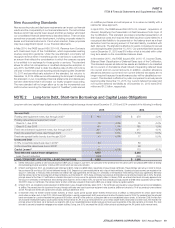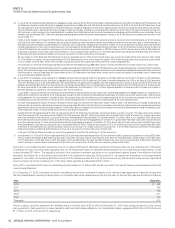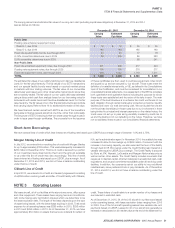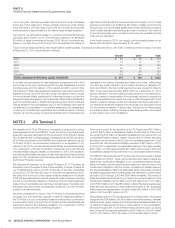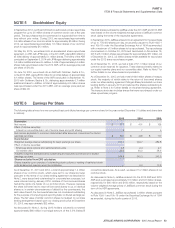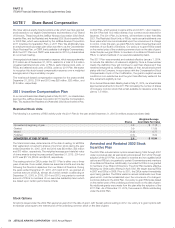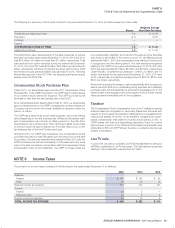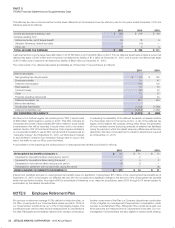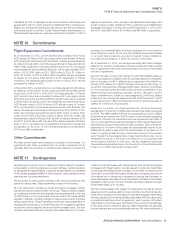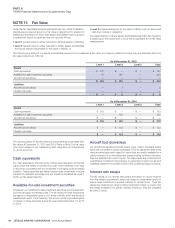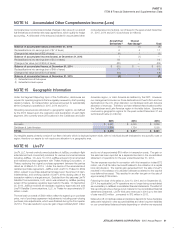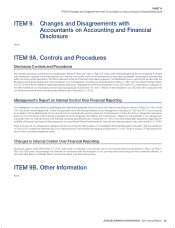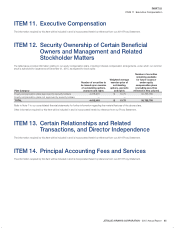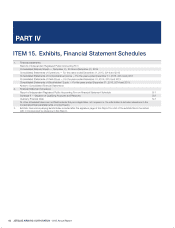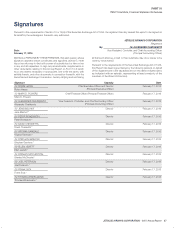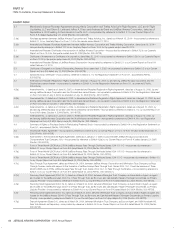JetBlue Airlines 2015 Annual Report Download - page 62
Download and view the complete annual report
Please find page 62 of the 2015 JetBlue Airlines annual report below. You can navigate through the pages in the report by either clicking on the pages listed below, or by using the keyword search tool below to find specific information within the annual report.
JETBLUE AIRWAYS CORPORATION-2015Annual Report58
PART II
ITEM 8Financial Statements and Supplementary Data
standalone environmental liability insurance policy to help mitigate this
exposure. Our existing aviation hull and liability policy includes some limited
environmental coverage when a cleanup is part of an associated single
identifiable covered loss.
Under certain contracts, we indemnify specified parties against legal liability
arising out of actions by other parties. The terms of these contracts range
up to 25 years. Generally, we have liability insurance protecting ourselves
for the obligations we have undertaken relative to these indemnities.
Upon the sale of LiveTV to Thales in June 2014, refer to Note 16 for more
information, we transferred certain contingencies to Thales. These included
product warranties and LiveTV indemnities against any claims which may of
been brought against its customers. These indemnities related to allegations
of patent, trademark, copyright or license infringement as a result of the
use of the LiveTV system.
Under a certain number of our operating lease agreements we are required
to restore certain property or equipment to its original form upon expiration
of the related agreement. We have recorded the estimated fair value of these
retirement obligations of approximately $5 million as of December 31, 2015.
This liability may increase over time.
We are unable to estimate the potential amount of future payments under
the foregoing indemnities and agreements.
Legal Matters
Occasionally we are involved in various claims, lawsuits, regulatory examinations,
investigations and other legal matters arising, for the most part, in the ordinary
course of business. The outcome of litigation and other legal matters is always
uncertain. The Company believes it has valid defenses to the legal matters
currently pending against it, is defending itself vigorously and has recorded
accruals determined in accordance with U.S. GAAP, where appropriate.
In making a determination regarding accruals, using available information,
we evaluate the likelihood of an unfavorable outcome in legal or regulatory
proceedings to which we are a party to and record a loss contingency when
it is probable a liability has been incurred and the amount of the loss can be
reasonably estimated. These subjective determinations are based on the
status of such legal or regulatory proceedings, the merits of our defenses
and consultation with legal counsel. Actual outcomes of these legal and
regulatory proceedings may materially differ from our current estimates. It is
possible that resolution of one or more of the legal matters currently pending
or threatened could result in losses material to our consolidated results of
operations, liquidity or financial condition.
To date, none of these types of litigation matters, most of which are typically
covered by insurance, has had a material impact on our operations or
financial condition. We have insured and continue to insure against most of
these types of claims. A judgment on any claim not covered by, or in excess
of, our insurance coverage could materially adversely affect our financial
condition or results of operations.
Employment Agreement Dispute. In or around March 2010, attorneys
representing a group of current and former pilots (the “Claimants”) filed a
Request for Mediation with the American Arbitration Association (the “AAA”)
concerning a dispute over the interpretation of a provision of their individual
JetBlue Airways Corporation Employment Agreement for Pilots (“Employment
Agreement”). In early July 2014, the AAA issued the arbitrator’s Final Award,
awarding 318 of the 972 Claimants a total of approximately $4.4 million,
including interest, from which applicable tax withholdings must be further
deducted. In January 2015, the New York State Supreme Court justice
confirmed the arbitrator’s Final Award and denied Claimants’ motion to
vacate the award. During the fourth quarter of 2015, JetBlue made payment
of the Final Award confirmed by the Court.
Litigation Recovery. During 2015, JetBlue reached an agreement with
respect to the settlement of a dispute. JetBlue recorded a benefit of $6.4
million related to this matter.
NOTE 12 Financial Derivative Instruments and Risk Management
As part of our risk management techniques, we periodically purchase over
the counter energy derivative instruments and enter into fixed forward price
agreements, or FFPs, to manage our exposure to the effect of changes in the
price of aircraft fuel. Prices for the underlying commodities have historically
been highly correlated to aircraft fuel, making derivatives of them effective at
providing short-term protection against volatility in average fuel prices. We also
periodically enter into jet fuel basis swaps for the differential between heating
oil and jet fuel to further limit the variability in fuel prices at various locations.
To manage the variability of the cash flows associated with our variable
rate debt, we have also entered into interest rate swaps. We do not hold
or issue any derivative financial instruments for trading purposes.
Aircraft fuel derivatives
We attempt to obtain cash flow hedge accounting treatment for each
aircraft fuel derivative that we enter into. This treatment is provided for
under the Derivatives and Hedging topic of the Codification. It allows
for gains and losses on the effective portion of qualifying hedges to be
deferred until the underlying planned jet fuel consumption occurs, rather
than recognizing the gains and losses on these instruments into earnings
during each period they are outstanding. The effective portion of realized
aircraft fuel hedging derivative gains and losses is recognized in aircraft
fuel expense in the period the underlying fuel is consumed.
Ineffectiveness can occur in certain circumstances, when the change in the
total fair value of the derivative instrument differs from the change in the
value of our expected future cash outlays for the purchase of aircraft fuel
and is recognized immediately in interest income and other. Likewise, if a
hedge does not qualify for hedge accounting, the periodic changes in its
fair value are recognized in the period of the change in interest income and
other. When aircraft fuel is consumed and the related derivative contract
settles, any gain or loss previously recorded in other comprehensive income
is recognized in aircraft fuel expense. All cash flows related to our fuel
hedging derivatives are classified as operating cash flows.
Our current approach to fuel hedging is to enter into hedges on a
discretionary basis without a specific target of hedge percentage needs.
We view our hedge portfolio as a form of insurance to help mitigate the
impact of price volatility and protect us against severe spikes in oil prices,
when possible.
The following table illustrates the approximate hedged percentages of our projected fuel usage by quarter as of December 31, 2015, related to our
outstanding fuel hedging contracts that were designated as cash flow hedges for accounting purposes.
Jet fuel swap
agreements
Jet fuel
collar agreements
Heating oil collar
agreements Total
First Quarter 2016 —% —% —% —%
Second Quarter 2016 —% —% —% —%
Third Quarter 2016 10% —% —% 10%
Fourth Quarter 2016 10% —% —% 10%



